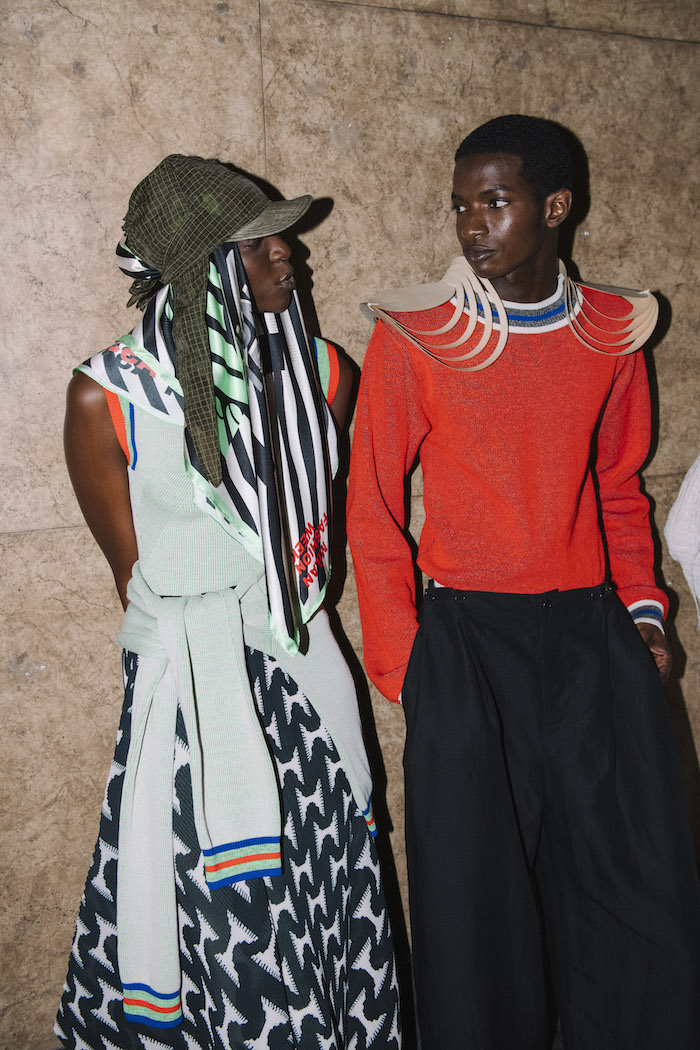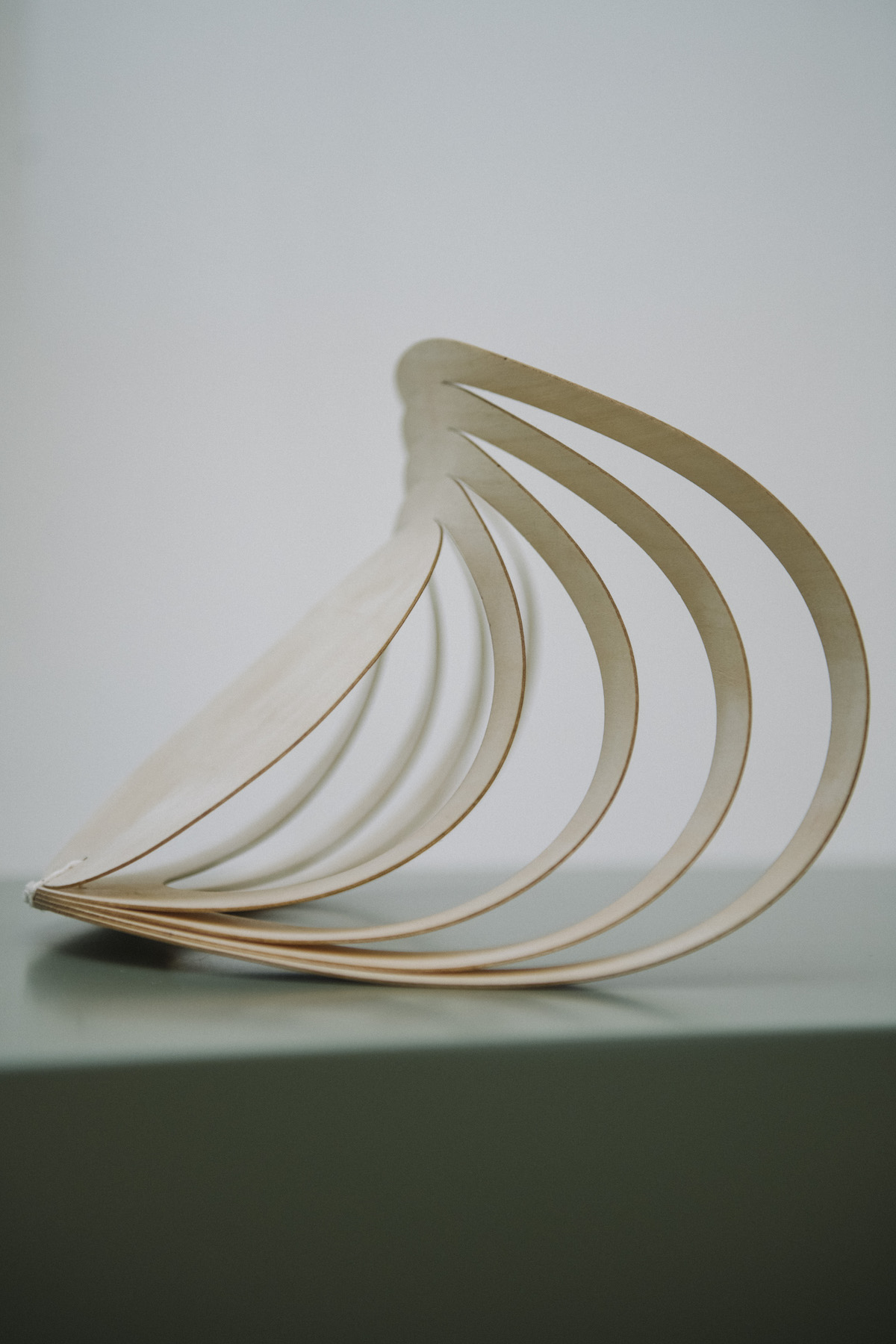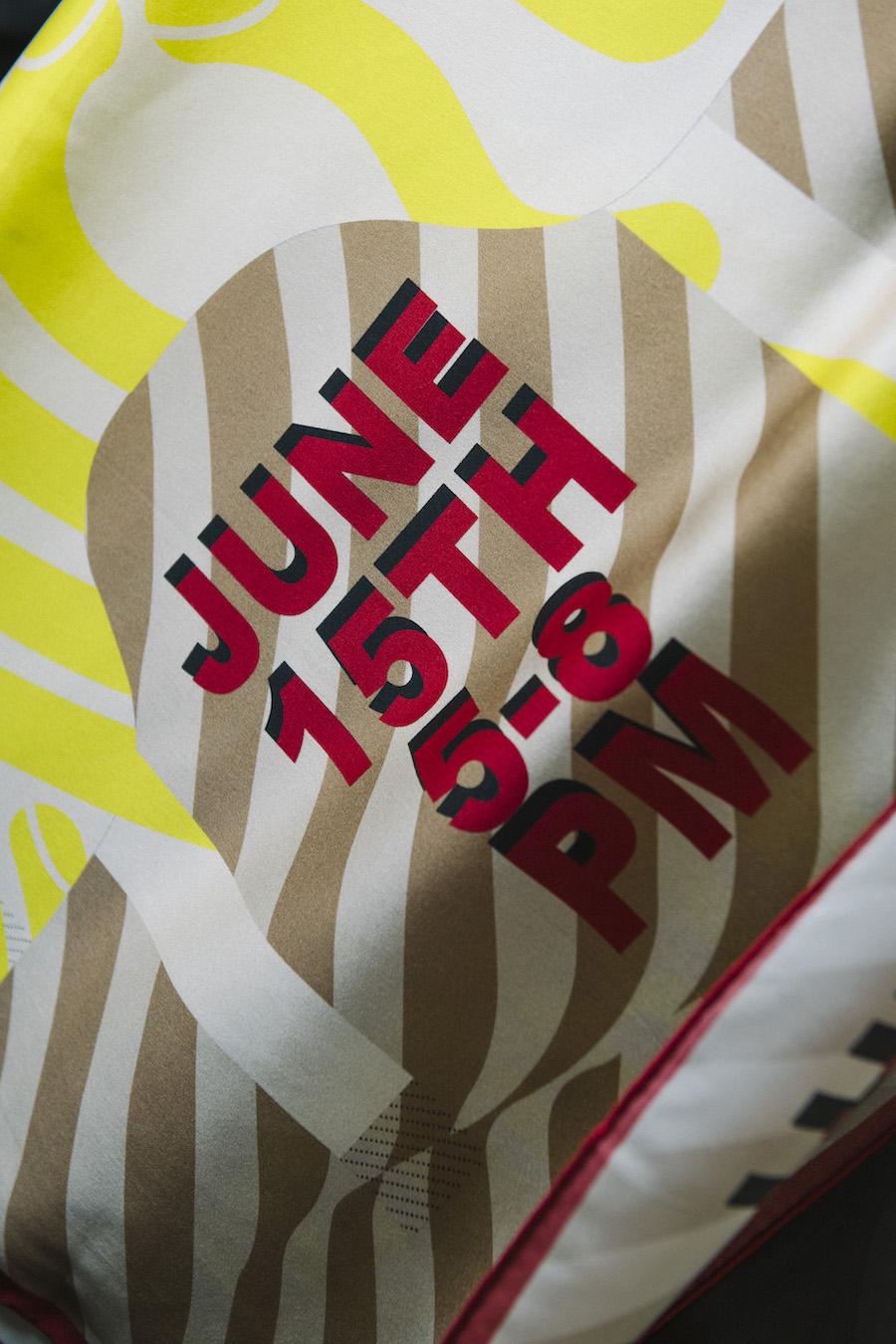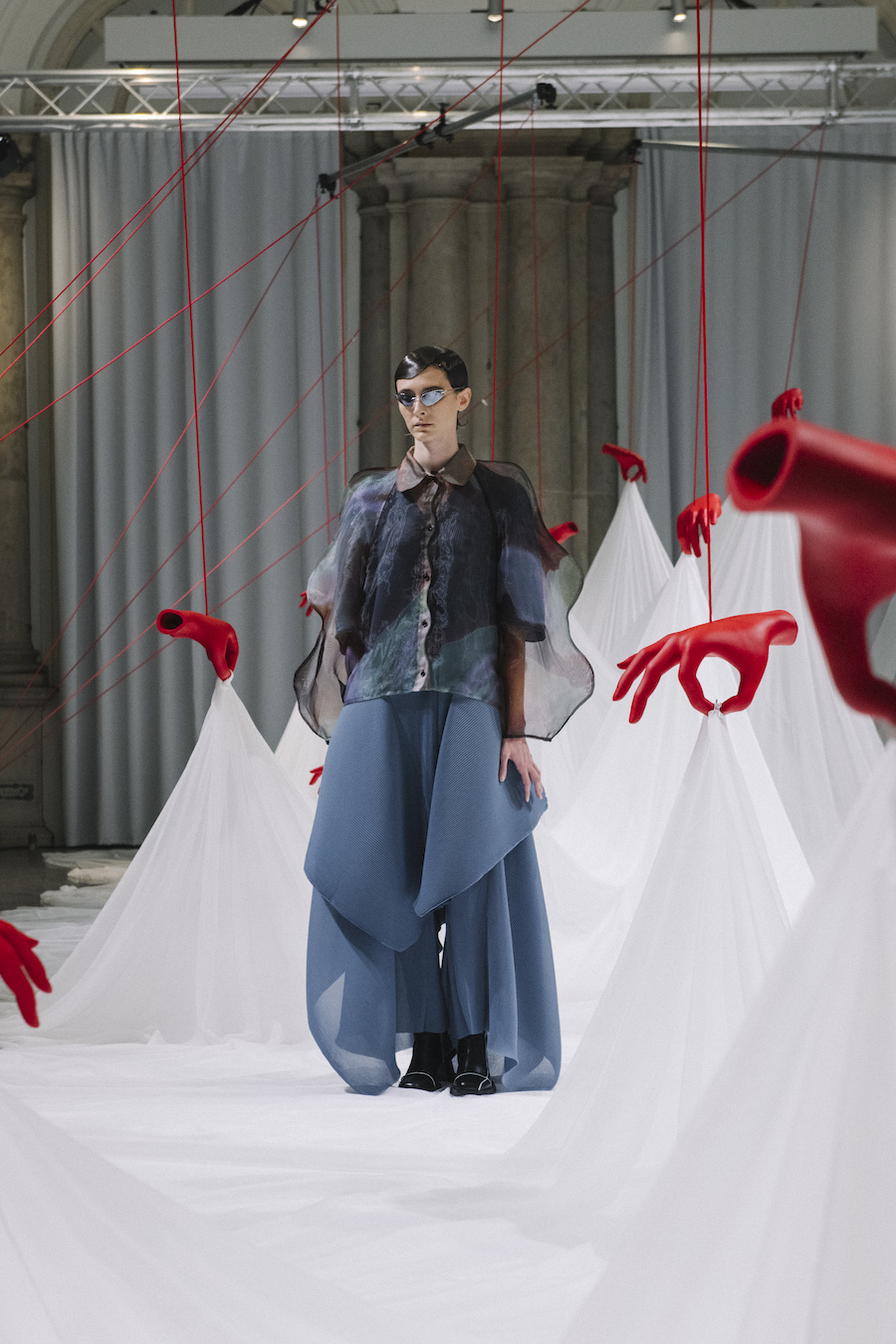This weekend, we had the chance to get away from the cold and rainy Amsterdam, looking for some sun in the vivacious and terribly frenetic Milan for the SS25 edition of Men’s Fashion Week. While the sun was definitely shying away even in the Italian city, Henrik Vibskov and his new collection brought a myriad of spring colours and gorgeous illusive shapes, which added a tangible calmness to the bustling city’s atmosphere. Frankly, it was exactly what we needed. We were welcomed to Palazzo dei Giureconsulti, right in the heart of Milan, to have a chat with the Danish designer. As we sat down, he immediately radiated a sense of tranquillity – which took us by surprise, considering the show would start in half an hour. He was collected and precise, but his grounded presence was amplified by a subtle sense of humour. This contrast between composure and irony shines through in his designs, too. It quickly becomes apparent that his use of complementary colours mirrors Vibskov’s own contrasting traits, which make each other stand out even more. We discussed the usual: blue cheese (the actual one), screen time, and nicotine chewing gums. Of course, among the pressing hot topics, he also tells us about his new collection, “The Orchestra of the Soft Assistance.” We go in depth about the symbolic meaning behind the show, as well as his distinctive techniques of colour combining paired with textile manipulation, inherent to his complex yet harmonious designs.
Hi Henrik, how are you today?
I’m good, I’m good.
Have you had the chance to visit Milan or has it all been too busy?
No, we arrived yesterday and I’ve been pretty busy for the last three, four days. Being part of a three-days design thing in Copenhagen. Two shows with the Swedish ballet. Then I also went to this little island for a sort of citizen meeting where a hundred thousand people came and had to talk about sustainability and new methods and science in textiles. And then to Milan.
Well, busy. Then hopefully you can get a long break soon. You are basically a polymath, an artist, designer, curator, musician, and even professor! Is there anything you can’t do? What else are you into right now?
I’m into basketball and taking good care of my family. I go around to a lot of basketball tournaments with the kids, and that actually takes a lot of my time.
You started out by getting into the music scene, and then the rest automatically unfolded with time. Being in a band you had these unspoken rules to life, from how to dress to what books to read.
Yeah, you could say I started when I was a teenager and continued through my 20s. I was part of a little bit of a dark scene, a noise scene. And yes, we had these unspoken rules, almost like a whole kind of micro society. And there I also started noticing how people were dressing.
Sounds like you were part of a sort of subculture. You know, a lot of discourse about the death of subcultures has been taking over the internet. Do you think a teenager or young adult would be able to have the same experience as you did when you completely immersed yourself in the creative world?
I think there’s still a lot of subcultures and, you know, it’s really something that has to do with taste and interests. We are, hopefully, all still a bit different. And I think it would always be part of the human identity, to stick out a little bit. I’m a little bit different than you, and you are a little bit different than me. And though that we measure ourselves a lot, towards friends and family, even colleagues. It’s a big part of how we create an energy that makes us want to try new things out.
You’re right, it’s kind of human nature to want to…
To experiment, and try things out, and obviously make mistakes and suddenly, through these mistakes, you might even get a Nobel Prize.

These unspoken rules were a part of this subculture you were part of, but rules do you live by now?
For sure, and it’s very much about, you could say, my screen time. Try to get off my phone completely, sometimes for a whole day, a whole week, a weekend. Leave the phone. And you know, contact others in more old school ways. I’ve been trying this for a few times now, and it’s definitely been interesting. You have to read books. Draw and play basketball or fish.
Now with social media, we don’t feel bored anymore. I can definitely see it with my youngest son. He finds being bored very difficult, but for me it’s super important because through boredom, you may find an interest, or start creating something yourself.
You learn how to focus and maybe come up with something unexpected.
Talking about screen time, how do you think that social media has impacted fashion, design, and art in general?
It has for sure created a much more visual focus. In some way, it is good from my side, since I work a lot with visuals, with pictures. But as a writer, then you could say the new text is an image, the image has become a new language.
You also had such an interesting education, from your design portfolio exploding when you applied for CPH’s design school, to enrolling to CSM, only to impress a girl. Can you tell me more about your youth and what made you want to be a designer?
Yes, but I really don’t know… It was a way to express my emotions, create a story, a fantasy. I was definitely a bit lost as well, so I could have ended up in many creative directions…
You play a lot with layers, both in clothes and in your art in general. One thing you have truly mastered is the mix and match of colours. You never shy away from using colours, bright ones. What do you look for in colours and how do you go about combining them?
You know, I realised this thing when I was working on my book during the pandemic, and was going through a lot of images and projects. I noticed a certain colour program, a sort of repetition in my designs. So suddenly I see that I was using a bit of the same colours or combinations of the same colours. Why those colours? I don’t know. It’s very intuitive. And it might mean something different depending on the period, it can also be referring to what’s going on in the world. Maybe right now it’s not the most punk coloured period. People are a little bit… Toned down, uncertain. Two wars. Two presidential elections. One in Taiwan, one in the States. So you can also see, actually, this collection, which is spring-summer, doesn’t have flashy punk colours, but it’s a little bit more earthy. Toned down. But maybe it’s a sign of time.
Maybe we’ll go back to the collection, look at it and think: “Oh, it made sense with that time in history.” The same thing goes for your materials, and this is a strong trait of your brand. For example, in your SS23 collection you had this skirt, and the fabric itself was pleated, but then there were other garments in that same collection had a pleated print. What effect do you hope to obtain when mixing media/textures?
We work a lot with European fabric mills and just try things out to challenge ourselves. So we’re constantly trying not to just do the same. And this practice is also very intuitive, it’s not like we have some sort of strategy. We might see something we’ve done before and really analyse the look, the way it moves on the body, and then decide to use it in a new way.

So do you think you look back also at your archive a lot?
Yeah, we use the old collections– shapes and colours, methods and techniques. It’s actually pretty common that when we sit down, do research, and suddenly some stuff from older collections pops up again. We really look into garments that never really bloomed, but still have a great shape, a great technique to them, and give them a second chance. A lot of reinterpreting as well, seeing another generation’s interpretation on what we did 15 years ago.
And I’m also wondering, when revisiting your archive and trying to figure out new combinations and new materials, new textures, what’s your creative process like? How do you keep that sort of direction for what you want? Is it intuitive?
We line up with a brief, a creative brief. It can be a theme. It can be a small thought on something. This time it’s about hands. What do the hands do? I look very much into the way we communicate with them: you say hello, you applaud. Hands are a big part of body language.
But also emotionally what hands can do and how important it is to have gestures for expressions like “Hello”, or “Welcome”. And when we had to come up with a theme, I thought of when, half a year ago, I was given a prize by the Danish king. When they called, my hands were completely mushed into blue cheese. And I was like, what’s this weird number calling? So I took the call, put it on speaker since you know… my hands were still in the cheese.
“Who?”
“Hello.”
“Can you speak one to one?”
“Not really.”
So that was kind of the starting point.
Also for the set, we’re using hands almost like a kitesurfing way. So they are standing in some kind of uniform, holding strings. So a little bit of an old school technique. Analogue.
And speaking about this collection called “The Orchestra of the Soft Assistance”, you already kind of touched upon this but what was generally the inspiration behind it?
Very symbolically: it’s the hands. But then it’s also assisting, a soft assistance. We have to assist each other somehow to get further for the future, to survive. We have to help one another. And then the orchestra, all the hands are forming the orchestra.


A lot of the titles of your collections are usually more of a statement, I see this choice as a sort of humorous take on your work, or maybe as a title of a short movie. How do you come up with these titles?
We spend quite a lot of time on it. We had “The Daily Chewing Gum Therapy”. At that time, there was so much talk in the studio about therapy. There was constantly something about therapy or someone who was feeling some sort of way. And at one point someone said, “how would your fantasy work be?” And someone put up a sticker saying, “Daily Therapy Sessions”. That was very interesting because, you know, the whole group is super fragile, including me. And then, what is my therapy? Chewing gum.. And I eat a lot of nicotine chewing gum. I’m kind of addicted. So that’s my therapy.
If it works, it works. I remember watching one of your interviews saying that fashion is more of a mass-produced design. And fashion can be art when there’s a sort of performance to it.
In general, I don’t think fashion can be classified as art. But sometimes something very unique can be made or can happen. So I don’t think, necessarily, all fashion is equal to art. But sometimes.
I think it’s also interesting because you’re a costume designer as well. And it’s for theatre performances, you know? How do you think it has affected your way of designing? When you create costumes for characters and you build a narrative.
Yeah, it very much goes hand in hand. I like that people have a character. I always build characters by wondering even the smallest details of their personalities.
Does he wear glasses?
Does he have a big nose, red cheeks?
Would he have a ring on or not?
Does he drink coffee?
You’re also a professor. How is that experience, coming into contact with young fashion students? Have they been teaching you anything?
I have this thing, which for me is super important, even for the future, to always have some experience where I can give back to other people. Teaching is one of them. I’m very fascinated with my student’s perspectives, how they live, and what they think about. I’m at the Danish Design School, where there’s a lot of focus on the environment, and you can really see the students kind of freaking out about how it’s evolving. And I always say that we can get through this only with education and science, so don’t stop. This is the way we can flip everything around. I think if we leave it to politicians only, things will not necessarily go the right way.
Words by Agata Villa
Images courtesy of the designer